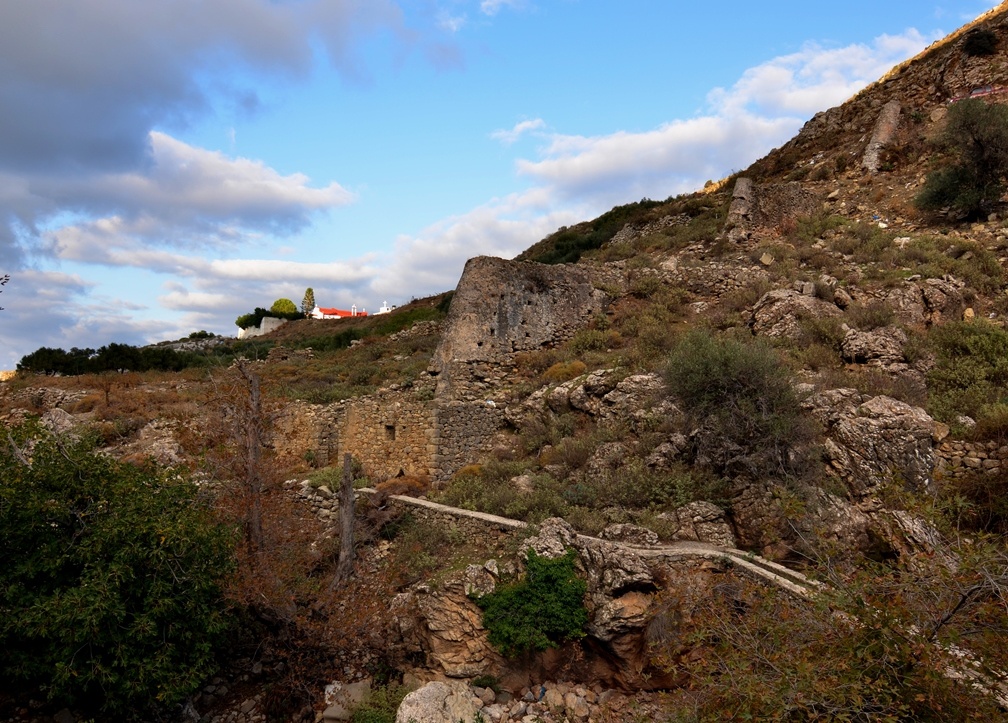
Distance from Heraklion: 49.5km
Amenities: Town hall, KEP [Citizens’ Service Centres], KAPI [Centres for the Open Care of the Elderly], police station, fire station, regional clinic, banks, post office, traditional taverns and cafés, shops, municipal canteen, lodgings, farmers’ market.
Pyrgos is the largest village at the foot of the Asterousia Mountain Range. It is the head village, where most citizen services for the residents of the southern part of the Municipality are to be found.
Its particularly favourable location played a definitive role in its growth and development into a central hamlet of the southern part of the Municipality, as well as of the broader region of Mesara. Built at the foot of the imposing Asterousia Mountain Range, in between and on top of hills that offered a good view of the entire valley, it secured its protection against intruders in times passed. The name itself (meaning Tower) indicates its fortifiable position, while, according to one account, it is connected to the Venetian Tower that was built at the peak of ‘Apano Pyrgou’, a rocky and barren hill to the east of the village.
Pyrgos is surrounded by 3 creeks with seasonal torrents that collect the rainwater on this side of the Asterousia, meeting the water supply needs of residents and the irrigation needs of their fields in Mesara, the most fertile valley on Crete, that spreads out at the feet of the village. The locals mainly work in farming, producing oil, table grapes and a cornucopia of vegetables.
Pyrgos is also a centre of cultural and other events for the villages of the southern part of the Prefecture of Heraklion, many of which are held at the man-made bocage to be found to the east of the village. Over the last few years the Pyrgos carnival has become an institution.
In Pyrgos there is also a children’s library, an interesting spot for children and young people to enjoy various activities.
What to see
- The hill of ‘Kakoplagos’: This is one of the hills on which Pyrgos is built and the point at which the old ill-preserved trail that used to connect Pyrgos to the village of Mournia starts.
- The hill of ‘Kefalas’: Another hill in Pyrgos at the peak of which stands the chapel of Agios Panteleimon (St. Pantaleimon). This is the starting point of the old and ill-preserved trail leading to the village of Prinia.
- The valley of Karava: Between the hills of Kakoplago and Kefalas there is a small valley, the valley of Karava, also known as Kavousi, with spring waters; it is rich in vegetation, mainly plane and walnut trees. The waters of Agios Mamas (St. Mammes) spring were channelled through pipelines and to run the flourmills that used to stand on the western side of Kakoplago. From there, the waters travelled along an arched hanging pipeline to the torrent on the opposite side and, continuing through another pipeline in the form of a chain, moved other flourmills. Rumour has it that there used to be 18 such flourmills. As they are horizontal mills, they are classified as Byzantine flourmills; while their architecture indicates that some were built during the Venetian rule, and others during the Ottoman rule, they always used the same construction style and architecture.
- ‘Ta Archontika’ (The Mansions) Hill with its off-white granite rock is where the local Venetian lord had his residence and where the area got its name from. Alongside and to the north of this mansion there was a spring that had been crafted into an intricate fountain for the water supply of the lord, which survived under the name ‘Archontissa’ (Lady). Few ruins of the residence and the fountain have survived, echoing the grandeur and aura of that age.
- Churches: The chapel of Agia Eirini (St. Irene) / the two-aisled chapel of Agios Georgios (St. George) and Agios Constantinos (St. Constantine) are decorated with noteworthy murals, while the dedicatory inscription displays the date 1314-1315. The church of Metamorphosis tou Sotiros (Transfiguration of the Saviour) and patron saint of the village (where, according to tradition, there used to be a convent)/ the chapel of Agios Raphail (St. Raphael) / the chapel of Agia Paraskevi (St. Paraskevi) and Profitis Ilias (Prophet Elijah).
- The Pyrgos Festival is held on 5-6 August.



 Pyrgos
Pyrgos